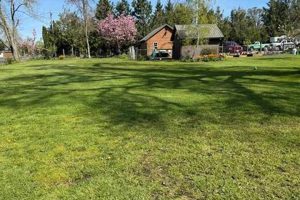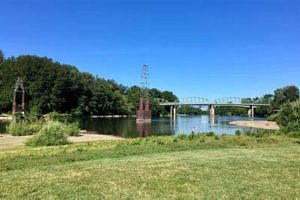Located in Oregon, this protected area functions as a recreational space and preserves a significant portion of the natural environment. It offers opportunities for camping, hiking, and exploring the unique ecosystem of the region.
The area serves as a vital habitat for diverse flora and fauna, contributing to biodiversity conservation. Established to honor Alfred and Andrew Collier, the park showcases historical logging equipment and buildings, providing insight into the region’s industrial past. Furthermore, its proximity to Spring Creek and the Williamson River makes it a notable destination for angling enthusiasts and those seeking waterfront leisure activities.
Further discussion will elaborate on its camping facilities, trail systems, historical features, and recreational opportunities, providing a more detailed overview of what the area offers visitors and researchers alike.
To ensure a rewarding and safe experience within the park’s boundaries, consider these essential points:
Tip 1: Planning and Reservations: Due to its popularity, especially during peak season, advanced reservations for campsites are strongly recommended. Confirm availability through the Oregon State Parks reservation system.
Tip 2: Understanding Environmental Conditions: Weather conditions in the region can change rapidly. Monitor forecasts and prepare for variable temperatures, precipitation, and potential fire hazards, particularly during the summer months.
Tip 3: Navigation and Wayfinding: While the park offers marked trails, utilizing a map and compass or a GPS device is advised, particularly when venturing into less-traveled areas. Familiarize yourself with trail difficulty ratings.
Tip 4: Wildlife Awareness: The park is home to diverse wildlife. Store food properly in designated animal-resistant containers to prevent attracting unwanted attention. Maintain a safe distance from all animals and never attempt to feed them.
Tip 5: Preserving Historical Artifacts: The park features historical logging equipment and buildings. Respect these artifacts by refraining from touching, climbing, or removing any items from their designated locations. Adhere to posted guidelines.
Tip 6: Water Safety: When engaging in water activities on Spring Creek or the Williamson River, exercise caution. Be aware of currents, water temperature, and potential hazards. Wear appropriate safety gear, such as life vests, when applicable.
Tip 7: Leave No Trace Principles: Practice responsible outdoor ethics by packing out all trash, minimizing campfire impacts, respecting wildlife, and leaving the area as it was found.
Adherence to these recommendations contributes to both personal safety and the preservation of the park’s natural and historical resources for future visitors.
The subsequent sections will further discuss the specific amenities and attractions within this unique Oregon state park.
1. Preserved Logging History
Within Collier Memorial State Park in Oregon, the preserved logging history serves as a tangible link to the region’s industrial heritage. This deliberate preservation strategy offers visitors an educational opportunity to understand the evolution of logging practices and their impact on the surrounding environment.
- Collection of Antique Logging Equipment
The park showcases an extensive collection of antique logging equipment, including steam-powered machinery, logging locomotives, and various hand tools. This equipment illustrates the technological advancements and labor-intensive processes involved in timber harvesting during the late 19th and early to mid-20th centuries.
- Restored Logging Camp Structures
Selected structures from historic logging camps have been carefully restored within the park. These structures provide a glimpse into the daily lives of loggers and their families, highlighting the living conditions and social dynamics prevalent in these remote communities.
- Interpretive Signage and Exhibits
Interpretive signage and exhibits strategically placed throughout the park offer detailed information about the history of logging in the region, the ecological consequences of timber harvesting, and the efforts to mitigate these impacts through sustainable forestry practices. These resources enhance visitor understanding and appreciation of the complex relationship between human activity and the natural landscape.
- Demonstration of Traditional Techniques
During certain times of the year, the park may feature demonstrations of traditional logging techniques. These demonstrations provide visitors with an experiential understanding of the physical demands and skills required for manual timber extraction, offering a more immersive historical perspective.
The careful preservation and interpretation of logging history within Collier Memorial State Park effectively conveys the significant role of the timber industry in shaping the region’s economic and social development. It also encourages critical reflection on the long-term consequences of resource extraction and the importance of responsible environmental stewardship.
2. Williamson River Access
The Williamson River, a significant waterway in southern Oregon, directly influences the character and recreational opportunities available at the park. Access to this river is a key feature that enhances the park’s value as a destination for both nature enthusiasts and those interested in the region’s ecosystem.
- Angling Opportunities
The Williamson River is renowned for its exceptional trout fishing. Access points within the park allow anglers to target trophy-sized Redband trout and other species. The river’s clear waters and diverse habitat support a robust fish population, making it a prime destination for fly fishing and other angling techniques. Regulations and licensing requirements apply to all fishing activities.
- Water-Based Recreation
While swimming is not always ideal due to water temperatures and currents, the Williamson River supports various water-based recreational activities within the park. Kayaking and canoeing are popular choices, allowing visitors to explore the river’s scenic beauty and observe wildlife along its banks. Designated launch points provide convenient access for these activities. Safety precautions, including the use of personal flotation devices, are strongly advised.
- Riparian Habitat Observation
The Williamson River’s presence creates a valuable riparian habitat within the park. This area supports a diverse array of plant and animal life, including various bird species, mammals, and amphibians. Access to the river allows visitors to observe and appreciate the ecological interactions within this unique environment. Interpretive trails and observation points may be available to enhance the visitor experience.
- Scenic Value and Aesthetic Appeal
The Williamson River contributes significantly to the park’s overall scenic value and aesthetic appeal. Its presence enhances the natural beauty of the landscape and provides a tranquil setting for relaxation and enjoyment. The river’s flowing waters and surrounding vegetation create a visually appealing environment for hiking, picnicking, and other outdoor activities.
The accessibility to the Williamson River significantly elevates the attractiveness of Collier Memorial State Park Oregon. Its value is derived from recreational angling to passive enjoyment, thus enriching visitor experiences and affirming the park’s significance as a hub for nature-based tourism.
3. Camping and Recreation
Camping and recreational opportunities are core components of the visitor experience at Collier Memorial State Park, Oregon. The parks infrastructure and natural setting are intentionally designed to facilitate outdoor activities, attracting a diverse range of users and contributing significantly to the local economy. The availability of designated camping areas, coupled with access to the Williamson River and surrounding trails, directly influences visitor numbers and length of stay. A decrease in the quality or availability of these resources would foreseeably lead to a reduction in park visitation. For example, limited campsite availability during peak season often necessitates advance reservations, highlighting the demand for this resource. Conversely, improvements to trail maintenance and the addition of accessible camping options can enhance user satisfaction and broaden the park’s appeal.
The specific types of recreational activities supported by Collier Memorial State Park extend beyond basic camping. Angling, as discussed earlier, is a major draw, directly linked to the health and accessibility of the Williamson River. Hiking trails cater to various skill levels, encouraging exploration of the park’s diverse ecosystem. The historical logging exhibit also provides a unique recreational element, blending outdoor activity with educational enrichment. Successful management of these resources requires ongoing assessment and adaptation to evolving user needs. This may involve the implementation of sustainable trail design practices, the monitoring of river water quality to ensure optimal fishing conditions, and the periodic updating of interpretive displays to maintain visitor interest.
In summary, the symbiotic relationship between camping, recreation, and the overall appeal of Collier Memorial State Park is undeniable. Effective management of these elements is essential for ensuring the park’s long-term viability as a recreational destination, a contributor to the local economy, and a protector of natural and cultural resources. Challenges include balancing increasing visitor numbers with the need to preserve the environment and providing diverse recreational opportunities that cater to a broad range of interests and abilities.
4. Unique Ecosystem Balance
Collier Memorial State Park in Oregon serves as a crucial area for the preservation of a specific ecological equilibrium. This park’s location at the intersection of diverse habitats creates a complex web of interactions between plant life, animal populations, and aquatic systems. The delicate balance is affected by various factors, including water flow from the Williamson River, forest management practices, and the presence of both native and invasive species. Disruptions to any one component can have cascading effects throughout the entire system. For example, altered water temperatures in the river, influenced by factors such as climate change and upstream diversions, can negatively impact fish populations and the aquatic insects they depend upon, affecting the food chain and potentially impacting larger terrestrial predators.
The park’s management strategies play a direct role in maintaining this unique ecological state. Efforts to control invasive plant species, such as non-native grasses that outcompete indigenous flora, are essential for preserving habitat diversity. Similarly, responsible forestry practices, including selective logging and prescribed burns, are implemented to reduce the risk of catastrophic wildfires and to promote the regeneration of native tree species. Furthermore, the park’s role as a protected area provides refuge for a variety of wildlife, including migratory birds, deer, and smaller mammals, all contributing to the intricate relationships within the ecosystem. Monitoring these populations and their interactions is crucial for understanding and mitigating potential threats.
Maintaining the ecosystem balance within Collier Memorial State Park necessitates a holistic approach that integrates scientific understanding with practical conservation efforts. The long-term health and resilience of the park’s natural resources depends on ongoing monitoring, adaptive management strategies, and continued public awareness of the importance of ecological preservation. Failure to protect this unique balance could result in a decline in biodiversity, degradation of water quality, and a loss of the park’s intrinsic value as a natural and recreational asset.
5. Historical Site Preservation
Historical site preservation is a central tenet in the management and interpretation of Collier Memorial State Park, Oregon. This preservation reflects an understanding of the park as more than a recreational area; it is a repository of regional history, particularly concerning the logging industry and early settlement patterns. Dedicated preservation efforts ensure the ongoing accessibility and educational value of these historical resources for present and future generations.
- Preservation of Logging Equipment
A key aspect of historical site preservation within the park involves the meticulous maintenance and conservation of antique logging equipment. Steam donkeys, logging locomotives, and various tools of the timber trade are carefully preserved to prevent deterioration from weather and vandalism. This equipment serves as a tangible representation of the technologies used during the height of the logging era, offering visitors a direct connection to the past. Failure to maintain these artifacts would result in their eventual loss and a diminished understanding of the region’s industrial heritage.
- Restoration of Historical Structures
Efforts are directed towards the restoration and stabilization of historical structures within the park, including replicas of logging camp buildings. These structures provide insight into the living conditions and social dynamics of logging communities. Preservation activities often involve the repair of deteriorated wood, the reinforcement of foundations, and the accurate reconstruction of architectural details. These efforts require specialized skills and materials to ensure authenticity and longevity.
- Interpretation and Education
Historical site preservation is inextricably linked to interpretation and education. The park utilizes interpretive signage, guided tours, and educational programs to convey the historical significance of the logging equipment and structures. This interpretation aims to provide context for the artifacts, explaining their function, their impact on the environment, and their role in shaping the region’s cultural identity. Effective interpretation enhances the visitor experience and promotes a deeper understanding of the past.
- Landscape Conservation
Beyond the preservation of specific artifacts and structures, historical site preservation also encompasses the conservation of the surrounding landscape. This involves managing vegetation, controlling erosion, and mitigating the impact of modern development on the historical setting. Maintaining the integrity of the landscape enhances the sense of place and allows visitors to experience the park in a manner that is consistent with its historical character.
The multifaceted approach to historical site preservation within Collier Memorial State Park underscores the importance of protecting cultural heritage for the benefit of present and future generations. These efforts not only preserve tangible artifacts but also contribute to a richer understanding of the region’s history and the complex relationship between human activity and the natural environment.
Frequently Asked Questions
The following questions address common inquiries regarding access, amenities, and regulations pertaining to Collier Memorial State Park.
Question 1: Is advanced reservation required for camping?
Campsites at Collier Memorial State Park are highly sought after, particularly during peak season. Advanced reservations via the Oregon State Parks reservation system are strongly recommended to secure accommodations.
Question 2: What are the primary recreational activities available?
The park provides opportunities for camping, hiking, fishing in the Williamson River, and exploration of the historical logging equipment exhibit. Water activities such as kayaking and canoeing are also permitted, subject to river conditions.
Question 3: Are pets permitted within the park?
Pets are generally allowed within Collier Memorial State Park, provided they are kept on a leash no longer than six feet and are under the owner’s control at all times. Pet owners are responsible for cleaning up after their animals.
Question 4: What historical resources are present in the park?
The park features a significant collection of antique logging equipment, including steam donkeys and logging locomotives. Replicas of historic logging camp structures are also present, offering insight into the lives of early loggers.
Question 5: What is the policy regarding campfires?
Campfires are permitted only in designated fire rings or pits within established campsites. Firewood may be available for purchase within the park. During periods of high fire danger, campfire restrictions may be imposed, and visitors should check with park authorities for current regulations.
Question 6: What is the best time of year to visit?
The optimal visiting period is typically from late spring through early fall, when weather conditions are most favorable for outdoor activities. Summers can be warm and dry, while winters can bring cold temperatures and snow.
These FAQs provide essential information for planning a visit to the park. Contacting park authorities directly for the most up-to-date regulations is always advisable.
The subsequent discussion will delve into potential challenges related to ecosystem management within protected areas.
Concluding Remarks on Collier Memorial State Park Oregon
This examination of Collier Memorial State Park Oregon has elucidated its multifaceted role as a recreational destination, a repository of regional history, and a vital component of the Oregon ecosystem. The park’s preserved logging equipment, its access to the Williamson River, its camping facilities, and its commitment to preserving unique habitats all contribute to its significance. Effective management of these resources is paramount for the park’s continued viability.
The continued preservation and thoughtful stewardship of Collier Memorial State Park Oregon are essential for safeguarding its natural and cultural heritage. The future of this area depends on sustained efforts to balance recreational use with environmental protection, ensuring that its resources remain available for future generations. Thoughtful action and commitment are required to uphold its long-term value.







